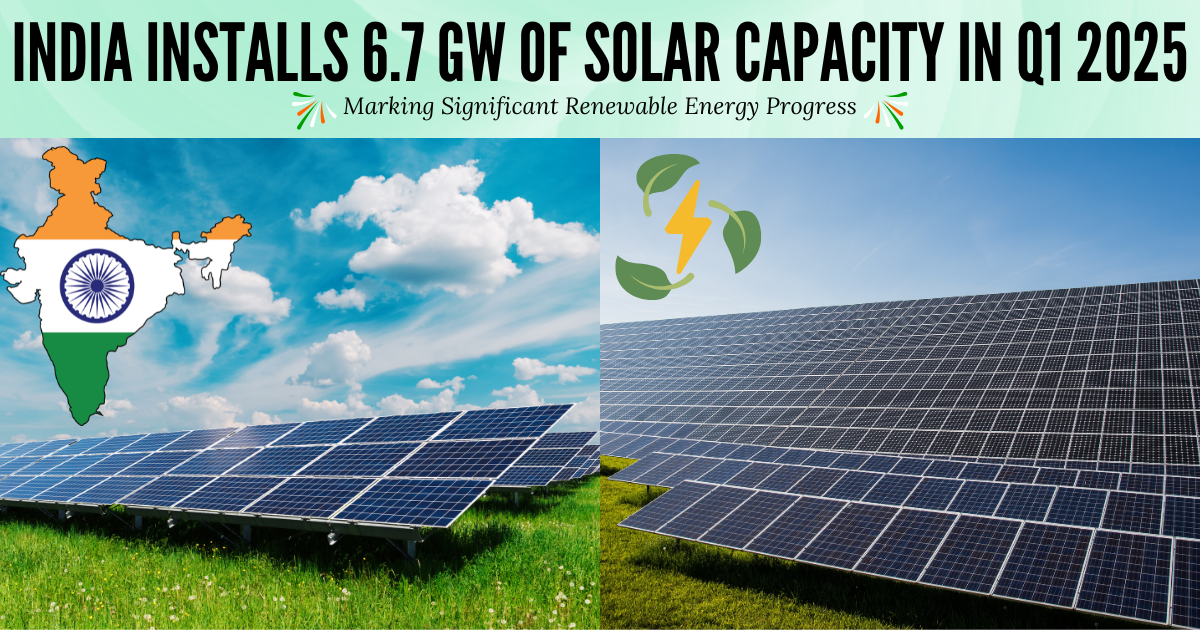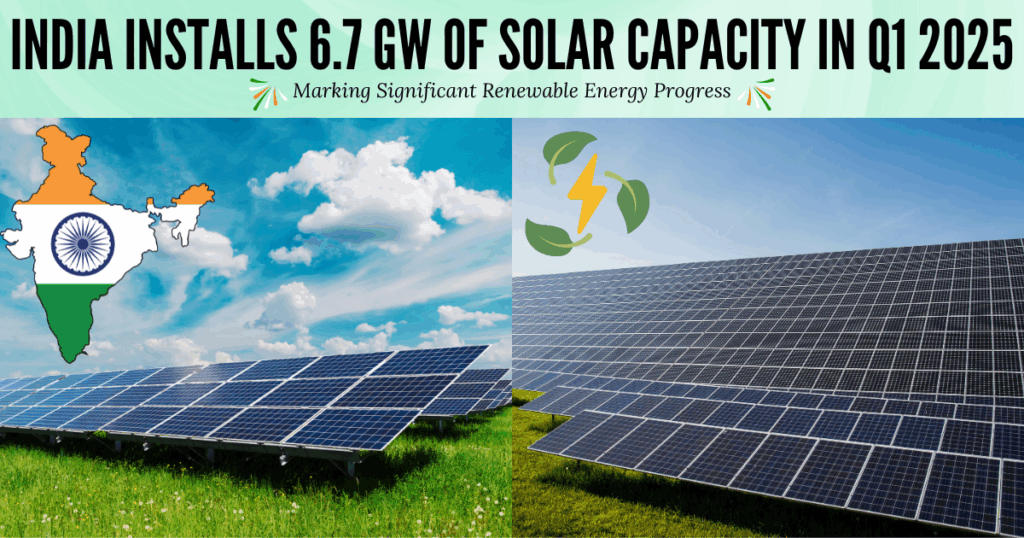India Installs 6.7 GW of Solar Capacity in Q1 2025, Marking Significant Renewable Energy Progress. India added 6.7 GW of solar capacity in the first quarter (Q1) of 2025, according to Mercom India’s latest Q1 2025 India Solar Market Update Report. Solar capacity additions decreased 25% year-over-year (YoY) compared to the 9 GW installed in Q1 2024, according to Mercom India’s newly released Q1 2025 India Solar Market Update Report. To know more about the topic, “India Installs 6.7 GW of Solar Capacity in Q1 2025, Marking Significant Renewable Energy Progress,” read the complete article.
India Installs 6.7 GW of Solar Capacity in Q1 2025, Marking Significant Renewable Energy Progress
India commissioned 6.7 GW of solar capacity in the first quarter (Q1) of 2025, representing a drop of 25% year-on-year (YoY) and 14% quarter-on-quarter (QoQ). Mercom India Research attributes the slowdown to numerous challenges, including the increasing cost of domestically produced modules and the limited availability and the lack of sufficient substation and transmission infrastructure for power evacuation. New additions during the reporting quarter include 5.5 GW from large-scale projects, which declined 15% QoQ and 36% YoY. Open access installations made up around 19.8% of this capacity. Gujarat contributed 30% of the total large-scale capacity, followed by Maharashtra with 16%, and Rajasthan with 35%.

Rajasthan and Gujarat led large-scale solar installations in the quarter, accounting for 35% and 30% of the capacity addition, respectively. Maharashtra ranked third, with 16%. The median cost of large-scale solar projects increased 3% QoQ and 1% YoY. “Indian solar installations were off to a slow start in Q1. While the project pipeline for 2025 is strong, a shortage of domestic modules and persistently high prices remain key concerns. Unless supply-side challenges are addressed quickly, project execution could stall,” said raj Prabhu, CEO of Mercom Capital Group.
“PPA and PSA signings continue to lag behind tenders, while land and transmission bottlenecks are slowing progress and delaying project commissionings. The government must act fast to approve the ISTS waiver extension and end the uncertainty surrounding it. Without an extension, a huge number of projects will become financially unviable, further disrupting the market.” As of March 2025, India’s cumulative installed solar capacity stood at 104.6 GW, accounting for 22% of the nation’s total installed power capacity and 48% of the total installed renewable energy capacity.
Key Capacity Achievements in Q1 2025
- Solar power capacity surpassed 100 GW in January 2025; total capacity stood at 105,646 MW by the end of March (an increase of 7,782 MW during the quarter). Solar installed capacity grew at a remarkable rate over a decade, from 2.82 GW in 2014 to 100 GW in 2025.
- Wind power capacity crossed the 50 GW mark, reaching 50,038 MW (an increase of 1,875 MW).
- Total non-fossil fuel power capacity reached 228GW in 1Q 2025, including contributions from hydro, biomass, waste-to-energy, and nuclear power.
- Hydro capacity increased by 760 MW in Q1, with new stations commissioned in Himachal Pradesh and Kerala.
- Waste-to-Energy capacity rose by 220 MW in the same period, and biomass-based capacity increased by 15 MW.
- Coal capacity recorded a net increase of 2,843 MW during Q1, driven by project completions across multiple states, although coal’s share in total installed capacity continued to decline to 46.7%.
Challenges and Opportunities
The decline in the rate of new installations can be explained by several factors, including supply chain disturbance and economic constraints. However, the Indian government has been active in solving these challenges with policy reforms and monetary incentives to attract investment in the solar sector.
One of the significant strategies has been the encouragement of domestic solar manufacturing, which not only helps local economies but also minimizes dependency on imports. This coincides with global trends where countries are increasingly concentrating on domestic production to increase energy security and create jobs.
Policies and Capacity Targets
India continues to achieve long-term clean energy goals assisted by active policy initiatives. The government’s objective is to install approximately 50 GW of non-fossil fuel power capacity yearly starting from 2023 in order to implement 500 GW of non-fossil capacity by 2030. Since 2018, the central government has continuously released tenders for solar, wind, hybrid, and energy storage projects. The volume of tendered capacity has risen since 2023, providing huge visibility and investment security to developers.
Additional policy measures have also supported capacity expansion and domestic manufacturing, including:
- PM Surya Ghar Yojana for promoting rooftop solar adoption
- PM-KUSUM scheme for solarisation of agriculture feeders and pumps
- Production-Linked Incentives (PLI) Scheme to boost manufacturing of solar modules and related equipment
These policies, along with a strong demand outlook, have created a favorable environment for private and public sector investments in clean energy.









